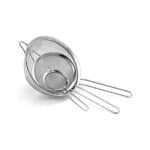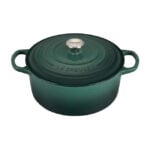One of the things I love most about Mexican cuisine? How you don’t just have one of a good thing but rather a whole slew of very delicious things! I mean, you don’t just have one street taco, you have all sorts of street tacos with all sorts of variations. Another “family” of Mexican recipes that have almost as many variations: enchiladas of which a favorite of ours is enfrijoladas (pronounced in-free-hoh-lah-dahs).
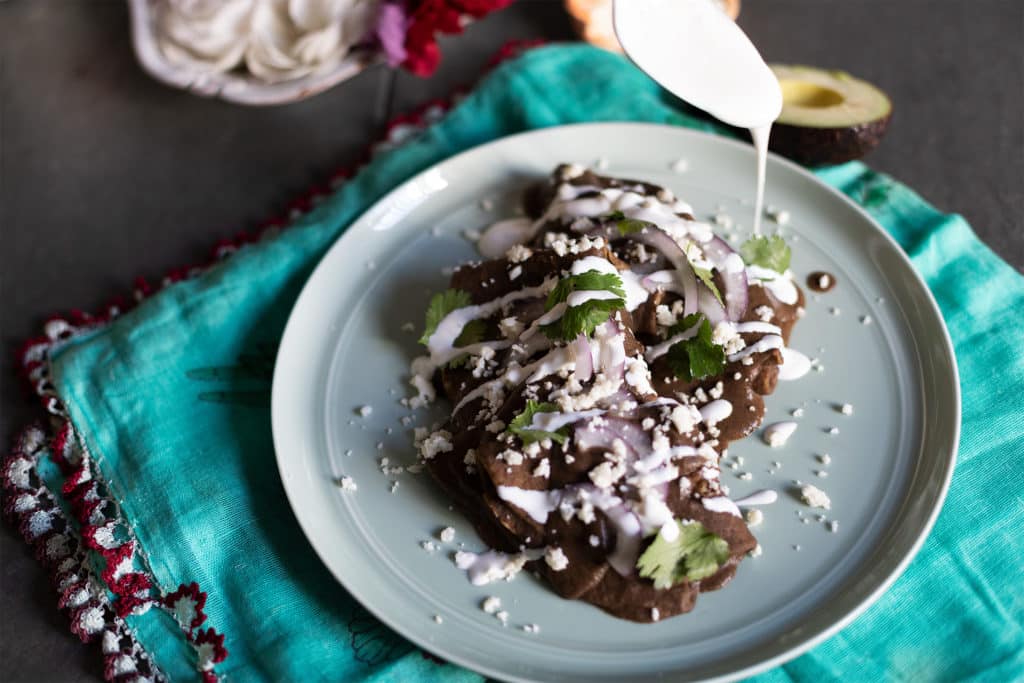
What Kinds Of Enchiladas Are There?
Similar to tamales, enchiladas are a seriously historic dish. It’s believed that some variations of enchiladas have been around since Mayan times. But close cousins to the well-known enchiladas are a bunch of other recipes where a tortilla gets dipped in goodness though not necessarily a chile sauce. You may have heard of a few and are wondering as to the difference between enmoladas vs enchiladas vs entomadas and enfrijoladas. Here is the lowdown:Enchiladas
The best known of the bunch, any time a tortilla is dipped in a chile-based salsa you have an enchilada.Enmoladas
Tortillas soaked in mole sauce (often black mole if you’re in Oaxaca) are known as enmoladas.Entomatadas
If the tortillas are in a tomato sauce but it does not have chiles, then you have entomadas.Enfrijoladas
So, you can probably guess then that enfrijoladas when tortillas get dipped in a bean salsa aka a chile-and-spiced flecked bean sauce.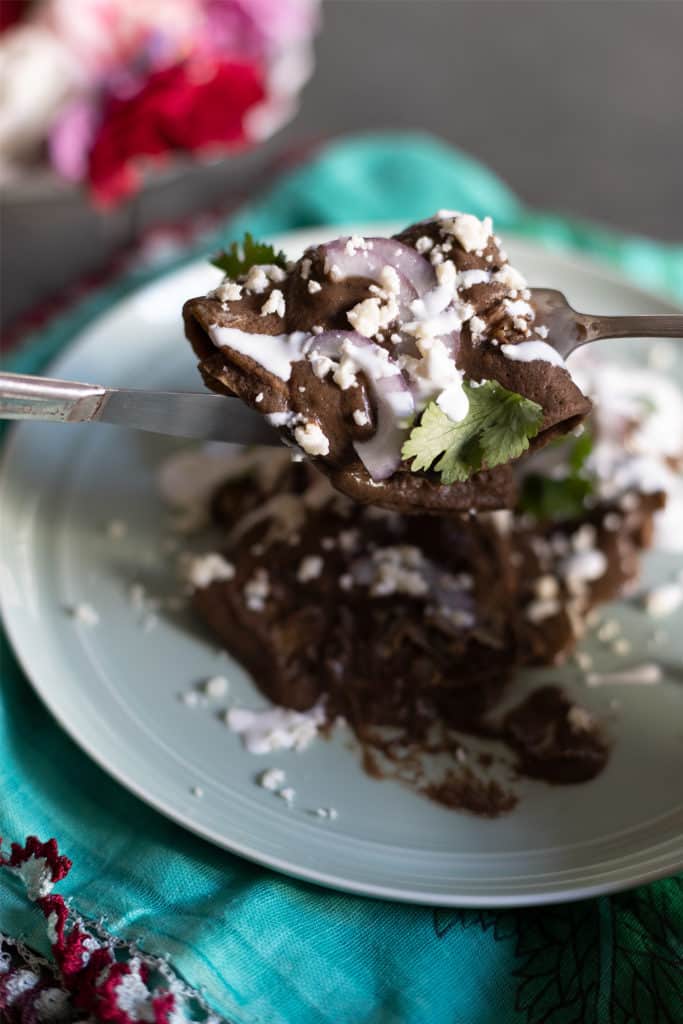
What Are Enfrijoladas Origin?
Now that we’ve answered “What are enfrijoladas?” you may be asking where they come from.
You’ll find them across Mexico but two of the best-known styles are the enfrijoladas Veracruzanas or the style in Oaxaca.
Veracruz style
Here enfrijoladas get filled with scrambled eggs and chorizo
Oaxacan style
Essentially the original black bean enchiladas and what the recipe we’re making here is inspired by. These are the enchiladas you commonly see when you’re traveling throughout the state of Oaxaca.
When Are Enfrijoladas Made?
While you can find enfrijoladas any time of year, they make a special appearance around the Day Of The Dead when many altars are adorned with a plate of them.
But there is no need to wait until the Fall to make these because they’re a great addition to your regular weeknight cooking rotation. They seem like a lot of steps, but, once you get the hang of things, it’s quick – I promise!
How To Make Enfrijoladas Quickly
This recipe is the full deal step-by-step of how to make enfrijoladas. That’s to say the Oaxacan black beans are cooked from scratch and it adds quite a bit of time to the recipe.
But you can make it with canned black beans to speed things up — just go ahead and start at the “To Make The Bean Salsa” section.
Or you can make the bean salsa a day or two ahead of time and, after warming it up, pick the recipe back up with “To Make The Enfrijoladas” section. Also, if you can’t find the dried chiles, you can use a couple of chipotles en adobo or chili powder (about 2 teaspoons) instead.
The recipe was written as is not just because it’s more traditional but because I fully believe it is more flavorful this way. That’s not to say that every time I make them, they’re exactly as written here. I use what I have on hand and adjust as needed.
Variations On Enfrijoladas
Speaking of changing it up, just like their cousin enchiladas, enfrijoladas know how to adapt. You can make them with canned beans instead of freshly cooked or make them with pinto beans or refried beans (though with refried beans you’ll want to process the rewarmed refried beans in a blender with at least 1 cup of liquid so it becomes thinner).
You can serve enfrijoladas folded in half instead of quarters (though they’ll get mushier even faster) and, yes, you can fill them and roll them up as you would with other enchiladas.
Also, if you want to make them more of a meal, you could fold in shredded chicken, cooked chorizo, shredded cheese, or scrambled eggs. Though, to be honest, we find the recipe as is to be a complete meal!
How To Serve Enfrijoladas
For serving, feel free to eat them as is or go all out on the garnishes. I’m partial to garnishing with sliced onions, crumbled queso fresco, drizzled crema, and some fresh parsley or cilantro.
And, though it’s not traditional — it’s even more delicious topped with avocado. When it comes to serving, the most important thing is that you serve them immediately because they get drier and mushy as they sit.
Go stock up on all your cooking essentials then head into the kitchen, make this, and share it with us by tagging @saltandwind and #swsociety on social!
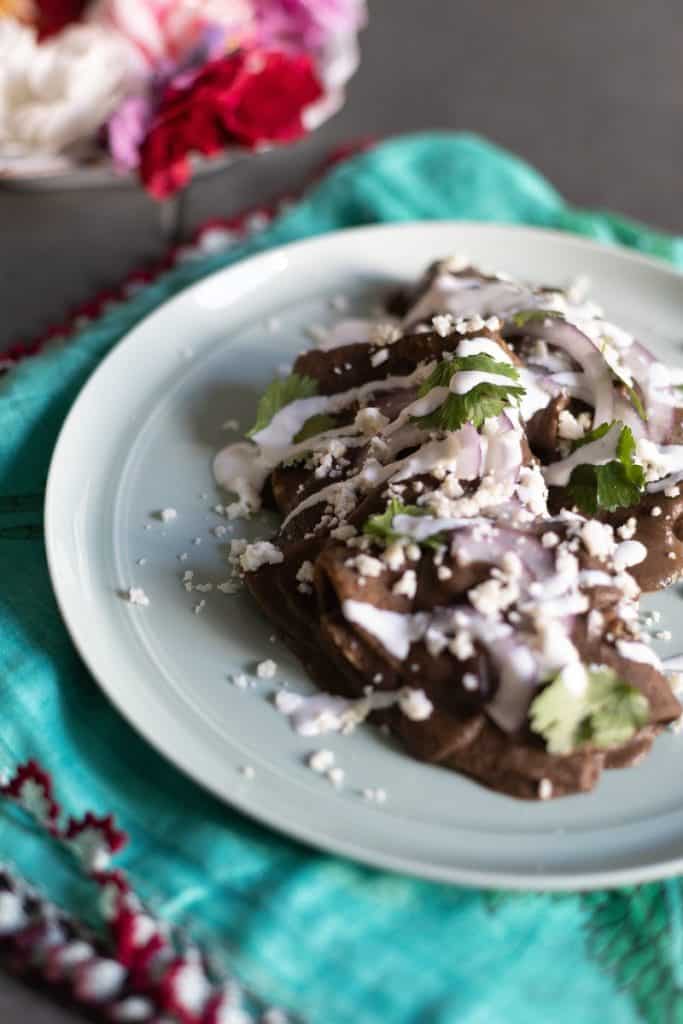
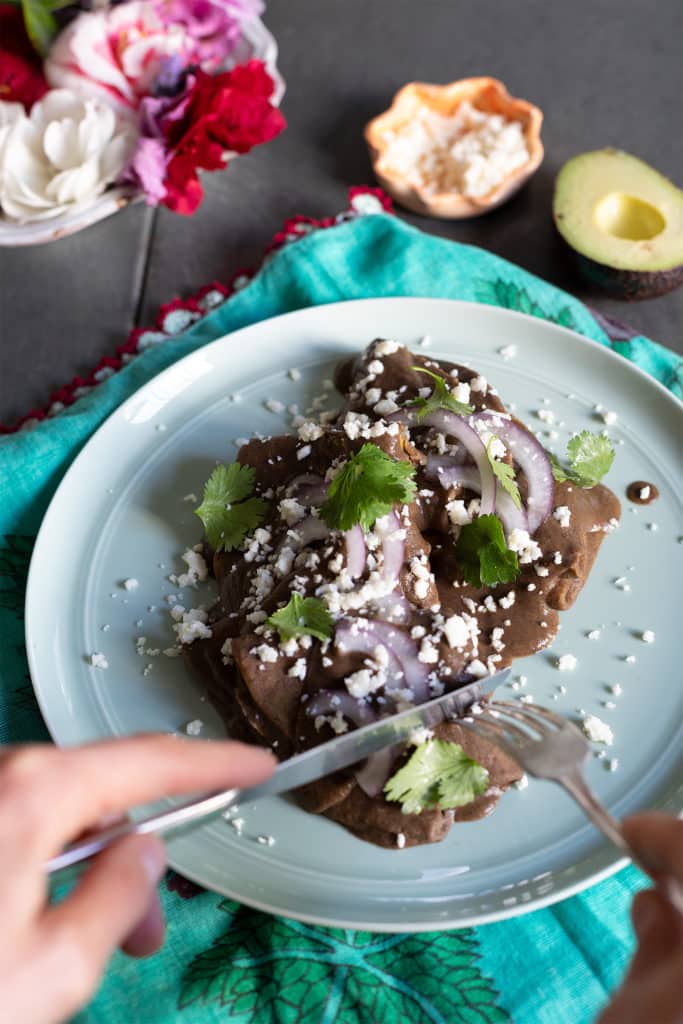
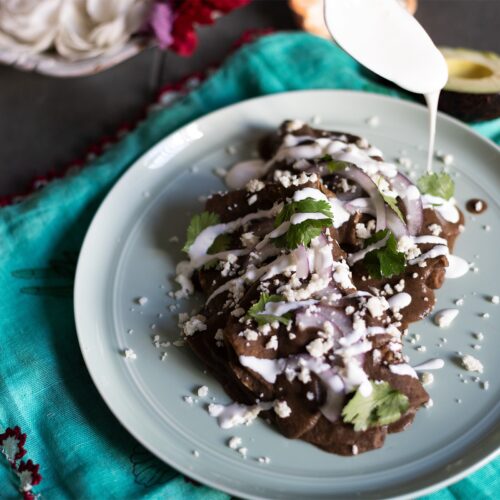
{Enfrijoladas} Black Bean-Smothered Enchiladas Recipe
Equipment
Ingredients
For The Black Bean Sauce:
- 1 pound dried black beans
- 2 dried bay leaves or 1 dried avocado leaf
- 1 white or red onion halved
- 4 garlic cloves 1 for cooking the beans, the other 3 thinly sliced
- 3 dried pasilla chile or dried Ancho chiles, or 2 chipotles en adobo (use 3 if you want it spicy)
- 1 tablespoon dried Mexican oregano or other dried oregano
- 1 pinch fennel seeds or 1 sprig fresh epazote
For The Enfrijoladas:
- 1/4 cup canola, grapeseed, or coconut oil
- 16 (6-inch) corn tortillas
For Garnish:
- Crumbled queso fresco or feta, for garnish
- Drizzle Crema or sour cream for garnish
- 1 handful fresh Italian parsley or cilantro leaves
- 1 medium firm-ripe avocado for garnish
Instructions
- Cook The Dried Black Beans: Place the dried beans in a fine mesh strainer then sort and rinse and remove any debris or broken bits. Place the beans in a bowl and cover by 2 inches of water then set aside in a cool, dry location to soak at least 6 hours and up to 24 hours. Once the beans have soaked, discard the water and rinse them off then transfer to a large Dutch oven or other heavy-bottomed pot and cover with 2 inches of water. Bring the beans to a boil over high heat then skim off any foam that rises to the surface. Reduce the heat to low, add one half onion, one garlic clove, and two bay leaves then and simmer. Periodically skim off any additional foam that rises to the surface. Simmer the beans, partially covered, until they're tender (adding more water as needed to just keep the beans covered), about 1 1/2 to 2 hours. The beans are just tender when you blow on the surface of a bean and the skin peels back easily. Also, they should be easy to bite into but not so soft they're mushy. If you're going to use the beans to make the bean sauce (below), discard the onion, garlic clove, bay leaves before proceeding.
- Make The Bean Sauce: When the beans are just tender, prepare the bean sauce. If using the dried chiles, place them in a dry cast iron pan or comal over medium heat and toast until they're fragrant. Place the chiles in hot water and soak for 10 minutes, or until soft. Drain and discard the soaking liquid then use kitchen shears to cut the soaked chile into strips (discard the stem).Place a small frying pan over medium heat and add 1 tablespoon of the oil. Dice the remaining half onion and slice the remaining three garlic cloves then add both to the pan with a big pinch of salt. Stir to combine then cook until the onions are soft, at least 5 minutes. If using the avocado leaf, epazote sprig, dried Mexican oregano, add them now. Otherwise, add in the (non-Mexican) dried oregano and the pinch of fennel seeds. Add the onion mixture to the beans and continue cooking until the beans are very tender and the broth has slightly thickened, about another 10 minutes.Remove the beans from the heat then strain the beans from the cooking liquid and reserve both. Transfer 2 cups of the beans and 2 cups of the bean cooking liquid (reserve the remaining beans and liquid for another use - you can freeze them!) along with the soaked and sliced pasilla chiles or the chipotle peppers, if using, to a food processor or blender. Blend for a long time (1 to 3 minutes) until you have a smooth sauce that resembles hot caramel.
- Make The Enfrijoladas: Heat the oven to 400°F and arrange a rack in the middle. Meanwhile, transfer the bean salsa to a medium frying pan, stir in 1 tablespoon of the oil, and just bring to a simmer over low heat. Stir and let cook until the salsa is warmed through and just thickens so slightly that it coats the edges of the pan. Taste and add more salt, as desired then turn off the heat. Brush the remaining 2 tablespoons of oil on one side of each tortilla and arrange the tortillas in a single layer on a rimmed baking sheet (it's okay if they overlap slightly). Transfer the tortillas to the oven and bake just until the oil is heated, the tortillas puff slightly, they're warmed through, and they're still pliable -- don't let them get crispy --about 3 to 5 minutes - then remove them from the oven (keep them on the baking sheet while you finish the recipe).Before you begin to coat the tortillas, gather a serving platter, a set of tongs, and make sure all your garnishes are ready to go becuase you'll want to serve and eat these immediately!To assemble the Enfrijoladas, use tongs to dip one of the warmed tortilla into the bean mixture and coat it on all sides. Allow any extra bean salsa to drip back into the saucepan, then with the help of a fork or using clean hands, fold the tortilla into quarters and place on a plate. Repeat with all the remaining tortillas.
- Serve The Enfrijoladas: Serve them topped as they would in Mexico with raw onion slices and crumbled cheese and a drizzle of crema. Or, if you want to up the ante (like we like to do!), add some fresh cilantro or parsley leaves and some avocado.

